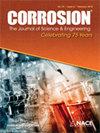通过低铜掺杂和热挤压协同提高 Ti6Al4V 合金的强度、延展性和耐腐蚀性
IF 1.1
4区 材料科学
Q4 MATERIALS SCIENCE, MULTIDISCIPLINARY
引用次数: 0
摘要
含铜的 Ti6Al4V 合金因其出色的抗菌性能而被认为是一种理想的生物医学材料。然而,添加铜会导致强度、延展性和耐腐蚀性不匹配,从而阻碍其进一步应用。为解决这一问题,该研究利用低铜掺杂和热挤压来优化材料的性能。结果表明,原生片状结构转变为等轴晶粒,平均晶粒大小从 10 μm 减小到 300 nm。纳米等轴晶具有均匀的元素组成和更强的基底纹理,其取向与挤压方向一致。因此,在强度、延展性和耐腐蚀性方面实现了协同强化。薄膜电阻从 127 kΩ-cm2 增加到 325 kΩ-cm2,极限拉伸强度 (UTS) 从 1030 兆帕增加到 1330 兆帕,伸长率从 7% 增加到 21%。这些改进归功于纳米结构和基底纹理,它们有助于形成更厚的被动膜,减少点蚀,从而提高耐腐蚀性。此外,纳米等轴晶粒还能加强晶界和纹理对 UTS 的影响,并确保伸长率的均匀变形。本文章由计算机程序翻译,如有差异,请以英文原文为准。
Synergistic enhancement of strength, ductility and corrosion resistance of Ti6Al4V alloy through low Cu doping and hot extrusion
Cu-containing Ti6Al4V alloy is considered an ideal biomedical material due to its excellent antibacterial properties. However, the addition of Cu leads to a mismatch in strength, ductility, and corrosion resistance, which hinders their further application. To address this issue, the study utilized low Cu doping and hot extrusion to optimize the material's properties. The results showed that the primary lamellar structures were transformed into equiaxed grains, with an average grain size reduced from 10 μm to 300 nm. The nano-equiaxed grains had a homogeneous elemental composition and a stronger base texture, with orientations aligned with the extrusion direction. As a result, synergistic strengthening in terms of strength, ductility, and corrosion resistance was achieved. The film resistance increased from 127 kΩ·cm2 to 325 kΩ·cm2, the ultimate tensile strength (UTS) increased from 1030 MPa to 1330 MPa, and the elongation increased from 7% to 21%. These improvements were attributed to the nanostructure and basal texture, which facilitated the formation of a thicker passive film and reduced pitting corrosion, thereby enhancing corrosion resistance. Additionally, the nano-equiaxed grains could provide grain boundary strengthening and texture strengthening on UTS and ensure uniform deformation for elongation.
求助全文
通过发布文献求助,成功后即可免费获取论文全文。
去求助
来源期刊

Corrosion
MATERIALS SCIENCE, MULTIDISCIPLINARY-METALLURGY & METALLURGICAL ENGINEERING
CiteScore
2.80
自引率
12.50%
发文量
97
审稿时长
3 months
期刊介绍:
CORROSION is the premier research journal featuring peer-reviewed technical articles from the world’s top researchers and provides a permanent record of progress in the science and technology of corrosion prevention and control. The scope of the journal includes the latest developments in areas of corrosion metallurgy, mechanisms, predictors, cracking (sulfide stress, stress corrosion, hydrogen-induced), passivation, and CO2 corrosion.
70+ years and over 7,100 peer-reviewed articles with advances in corrosion science and engineering have been published in CORROSION. The journal publishes seven article types – original articles, invited critical reviews, technical notes, corrosion communications fast-tracked for rapid publication, special research topic issues, research letters of yearly annual conference student poster sessions, and scientific investigations of field corrosion processes. CORROSION, the Journal of Science and Engineering, serves as an important communication platform for academics, researchers, technical libraries, and universities.
Articles considered for CORROSION should have significant permanent value and should accomplish at least one of the following objectives:
• Contribute awareness of corrosion phenomena,
• Advance understanding of fundamental process, and/or
• Further the knowledge of techniques and practices used to reduce corrosion.
 求助内容:
求助内容: 应助结果提醒方式:
应助结果提醒方式:


